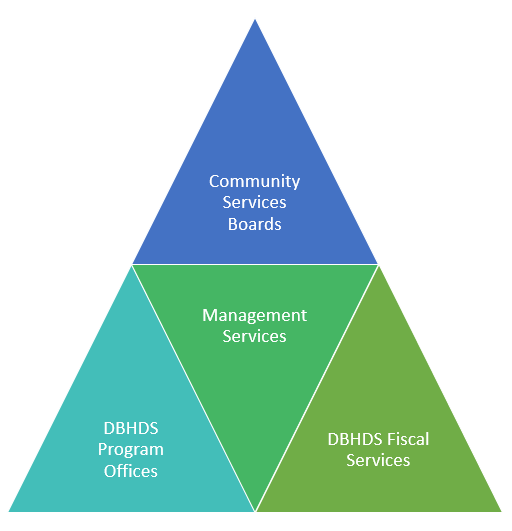Office of Management Services
The DBHDS Office of Management Services (OMS) acts as a bridge between divisions within DBHDS and the Community Services Boards. Primarily, this work revolves around the Performance Contract between DBHDS and the CSBs.

In addition, OMS facilitates the receipt of CSB data, consults on CSB administrative and management issues, interprets policies and procedures, fosters mutual understanding and cooperation between CSBs and DBHDS, and works with advocacy organizations and stakeholders.
Office of Management Services Personnel
Brian Watson
Deputy Director
Brian.watson@dbhds.virginia.gov
The Office of Management Services is a component of the DBHDS Office of Enterprise Management Services:
Chaye Neal-Jones, Director, Enterprise Management Services
chaye.neal-jones@dbhds.virginia.gov
Performance Contract Support: performancecontractsupport@dbhds.virginia.gov
Public Resources
- 01._FY24-FY25 Community Services Performance Contract General Terms and Conditions
- 02. PC_FY24-25 Exhibits A-M and Addendums I-III Combined
- Amended FY 2022-2023 Performance Contract (effective 1 July 2022 – 30 June 2023) (This is a Compressed folder containing separate documents)
- Amended FY 2022-2023 Performance Contract (effective 1 July 2022 – 30 June 2023) (This is the amended contract all in one document)
- Original FY 2022-2023 Performance Contract (effective 1 July 2021 – 30 June 2023) This is the original version of the current PC all in one document)
- FY24-25 Community Services Board Performance Contract Amendments
- FY24-25 AMD MASTER CSB Performance-Contract
- P1636.1 Exhibit A AMD FY24-25 PC-Resources and Services EX TEMPLATE
- P1636.1 Exhibit B AMD FY24-25-CQI
- P1636.1 Exhibit E AMD FY24-25 PC Schedule and Process
- P1636.1 Exhibit G AMD FY24-25 CSB Master Programs Services Requirements
- Exhibit M AMD FY24-25 DOJ Settlement Agreement Requirements
- FY2023 CSB Overview
- POLICY 4010 (CSB) 83-6 Local Matching Requirements for Community Services Boards and Behavioral Health Authorities






